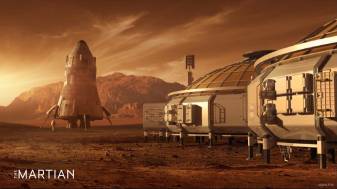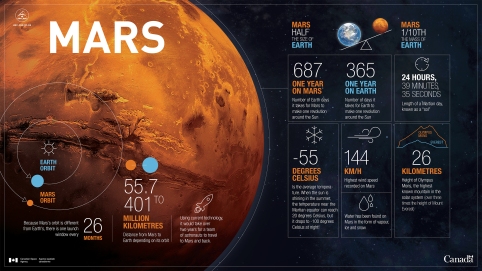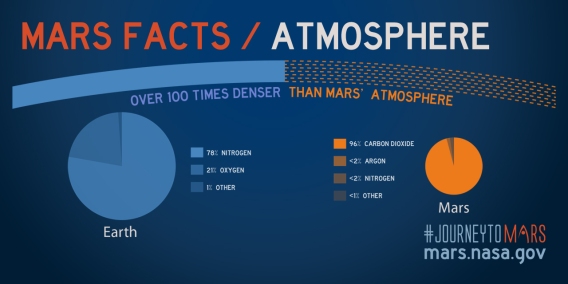In October 2016 and again in October 2017 I wrote two blog-posts about our exploration and eventual colonization of the red planet Mars. To date the Soviet Union, Great Britain, and NASA have delivered a total of seven unmanned rovers to Mars. Currently there are proposals and plans for satellite orbits, landers, rovers, and eventually crews onto Mars by the U.S., the European Space Agency, China, and Russia between the mid-2030’s and 2060. The lone private enterprise so far is SpaceX. Telling and imagining these Martian efforts on television will return again this coming Monday evening, November 12th on the National Geographic Channel’s second season of “Mars.” Getting there after around 7-months of spaceflight and surviving the first SOLs/days (or seasons of the Martian calendar) are not the only serious challenges. Coexisting with each other will be another on a long, long list of challenges that never really end.
If you think coexisting is sometimes difficult here on Earth, even with family, where we have so many benefits and luxuries we take for granted daily, then talk to Gerald Carr, Edward Gibson, and William Pogue about how in 1973 just 84-days together inside Skylab 4 turned out! The biggest major problem for those three astronauts? Workaholism. Excessive workaholism to be more accurate. But to be safe and survive way out there is workaholism what will be required of Martian travelers and colonists?
There are a number of plans from various governmental, scientific, and commercial entities already in progress to gradually move humans from “Earth-reliant” stations (currently the ISS), to “Cislunar space” that is still Earth-reliant, and then beyond our Moon into deep space travel to another planned Mars orbiting habitat/station (a transfer station, if you will), and finally onto the surface of Mars. Many supplies, equipment, and some raw materials will be waiting, shipped there for them months, years earlier. However, before the latter stages of these plans can unfold, we must first confirm that some basic elements, like water, microbes, and geothermal hot-spots underneath Martian soil, are still present in light of those components having existed in higher amounts on Mars 3.8 – 3.5 billion years ago. Dr. Dava Newman, former Deputy Administrator of NASA, explains that so far the news of necessary life-building resources on Mars are very encouraging, however:
For such a voyage [of boots on Mars], measured in years, astronauts will have to become Earth-independent, devising ways to make fuel, water, oxygen and building materials with whatever resources the Red Planet offers. If that seems as fantastical as Matt Damon growing potatoes in The Martian, Newman shrugs: Astronauts have dined on lettuce and peppers grown aboard the space station.
All the same, these are nonhuman concerns. What are the serious and pressing psychosocial challenges for space and Mars habitation? Making it to the red planet requires obvious, daunting, precise space and extra-planetary science, preparation, and training, but it requires just as much human science. Given how deterred and unfavorably psychology, neurology, biology, philosophy, and sociology (to name only five areas) have battled in the U.S. for widespread legitimacy the last century, the Human sciences are perhaps less prepared to face a life far away from our perfectly suited green and blue planet.
Here’s another influencing factor: because expeditions to Mars will likely be international collaborations, those astronauts and Martian colonists must overcome cultural differences to survive and thrive while on Mars. Communication between Earth and Martian expeditionary craft take 20-minutes to be received — which means 40-mins could pass before an answer is received on a spacecraft or Mars colony. Are these factors insurmountable? No, but they do compound the mental and behavioral health of astronauts and Martian colonists.

Your home from 127-million miles from Mars; taken by the Mars Reconnaissance Orbiter camera in Nov 2016
ISS crew-members have always praised the emotional, inspirational, and transcendental effect staring back down at Earth gives to them. But that is nothing like the possible effect of barely seeing your home as a tiny dot 35 – 37 million miles away (see MRC photo). Living in micro-gravity and zero-gravity pose several challenges on the human physiology. Space radiation has significant threats to human DNA, tissue, and cells which impact our central nervous system altering the structure and functions of the brain. Kidney stones become more common in altered gravity environments, which also leads to urinary track infections, which undetected can lead to confusion or delirium, which can be mistaken for a psychiatric disorder. And then there are the social difficulties of prolonged weightlessness and confinement of a group or crew.
In 2010-2011 the Mars-500 project, directed by the Institute of Biomedical Problems of the Russian Academy of Sciences, tested and studied six male participants from several countries for 520-days in a small Mars-like module. The results of the project revealed some encouraging as well as potentially significant psychosocial concerns. These ranged from friendly constructive interactions to errors in experiments and daily routines caused by sleep deprivation and exhaustion. Some crew-members became more sedentary after just 2-3 months. Their activities continued to decline for the next year. Due to the stress and exhaustion of two participants and simulated problem-events, 85% of the perceived conflicts among crew members and with mission control involved these two crew-members. For a better informed understanding of these psychosocial challenges in epic space-travel, read Mission to Mars by the American Psychological Association.

All of these concerns, however, do have some solutions. Surprisingly, cultural differences and language difficulties did not bear any significant influence. This is likely due to the fact that crew-members were so involved in each other’s daily routines and such intimacy is conducive to quicker collaboration and problem-resolution as opposed to those who are complete strangers and continents apart.
We are certainly prepared and capable of manned spacecraft to Mars and its colonization from a scientific nonhuman perspective, but are we as ready and prepared for the journey and life in deep space and on the red planet from a human sciences perspective? Maybe National Geographic Channel’s season 2 of Mars will help determine that… at least in the public’s mind, maybe. Come this Monday I will be watching and learning.
————
Live Well — Love Much — Laugh Often — Learn Always

Blog content with this logo by Professor Taboo is licensed under a Creative Commons Attribution-NonCommercial 4.0 International License.
Permissions beyond the scope of this license may be available at https://professortaboo.com/contact-me/.

 Earth-bound nations and their people have a long, long history of fighting each other and not getting along. What happens on Mars, or any celestial body, when Earthly independent nations with their own agendas start mixing with or conflicting with foreign foreign agendas? Watney indeed talked about those guidelines in the film, that applied back on Earth and Earth’s orbits, but what about on Mars?
Earth-bound nations and their people have a long, long history of fighting each other and not getting along. What happens on Mars, or any celestial body, when Earthly independent nations with their own agendas start mixing with or conflicting with foreign foreign agendas? Watney indeed talked about those guidelines in the film, that applied back on Earth and Earth’s orbits, but what about on Mars?


 Professor T:
Professor T:








